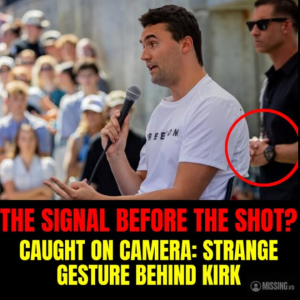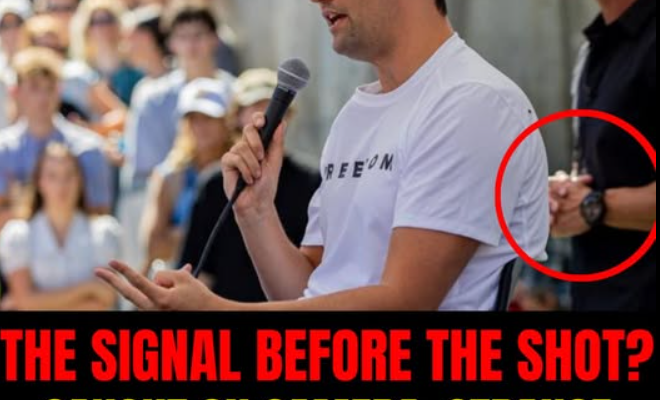The Signal That Wasn’t: Unpacking the Viral Speculation Before Charlie Kirk’s Shooting
In the moments before Charlie Kirk was fatally shot at Utah Valley University, a video clip began circulating online that sent the internet into a frenzy. It showed a man standing behind Kirk, adjusting his hat in a deliberate motion. To some viewers, it looked like a covert signal—perhaps military, perhaps conspiratorial. Theories exploded across social media. Was this man involved? Was the gesture a cue for the assassin?
But as the dust settled and facts emerged, the truth proved far less sinister—and far more human.
The Viral Clip
The footage in question was captured during Kirk’s speech to a crowd of over 3,000 attendees. In the video, a man in a white t-shirt, sunglasses, and a baseball cap stands behind Kirk. He places his hand on his cap and tips it downward. The gesture is subtle, but in the context of what followed—a single gunshot that killed Kirk—it took on an outsized significance.
Social media users began dissecting the clip frame by frame. Some claimed the gesture resembled a military hand signal. Others speculated it was a cue to the shooter, who was later identified as 22-year-old Tyler Robinson. Theories ranged from plausible to absurd, but all shared one thing: a hunger for meaning in the chaos.
Who Was the Man?
The man in the video was quickly identified as Dr. Frank Turek, a Christian apologist, author, and longtime friend of Charlie Kirk. Turek had appeared with Kirk many times before, including on podcasts and public panels discussing morality, politics, and faith.
As the speculation intensified, Turek’s team released a statement on his behalf, categorically denying any involvement in the shooting. “The viral accusations against Dr. Frank Turek are categorically false,” the statement read. “Dr. Turek was at Utah Valley University as part of Charlie Kirk’s team, standing with him as a close friend and mentor”.
Turek himself was reportedly devastated by the tragedy and declined all media interviews out of respect for Kirk’s memory. His team emphasized that he had provided assistance during the incident and was mourning alongside the rest of Kirk’s inner circle.
The Power of Perception
Why did this moment—a simple hat adjustment—ignite such a firestorm?
In part, it’s the nature of traumatic events. When something shocking happens, especially in public, people search for patterns. They want to understand, to explain, to assign blame. In the absence of clear answers, even the smallest gestures can become loaded with meaning.
The gesture also occurred in a highly charged political context. Kirk was a polarizing figure, and his assassination came at a time of heightened tension in American politics. Theories about secret plots and inside jobs are not new—but in the age of social media, they spread faster than ever.
Echoes of Past Conspiracies
Some users compared the man in the video to a Secret Service agent who had protected President Donald Trump during an assassination attempt in 2024. “The guy behind Kirk sure looks familiar,” one person wrote on X (formerly Twitter). Another added, “One of the guys making hand signals seconds before the shot looks awfully familiar”.
But others quickly debunked the claim. “Not the same guy,” one user clarified. “The guy in the Charlie Kirk video was his personal security guard and has traveled with him to multiple events.” The resemblance, if any, was coincidental.
Still, the comparison added fuel to the fire. It suggested a broader narrative of political violence and shadowy connections—one that resonated with audiences primed by years of conspiracy-laden discourse.
The Shooter’s Motive
While the signal theory was ultimately disproven, the motive behind the shooting was disturbingly real. Tyler Robinson, the alleged assassin, had left behind bullet casings inscribed with cryptic messages:
- “Hey fascist! Catch!”
- “If you read this you are gay LMAO”
- “Bella Ciao”
The final phrase, “Bella Ciao,” is an anti-fascist anthem from World War II, often used by leftist movements. The inscriptions suggested a politically motivated crime, one rooted in ideology and rage.
Robinson’s family later revealed that he had become increasingly political and “full of hate” in recent years. His descent into extremism was gradual but unmistakable. The shooting was not random—it was a targeted act of violence against a figure he viewed as emblematic of everything he opposed.
The Role of Media and Misinformation
The spread of the “signal” theory highlights a broader issue: the erosion of media gatekeeping. In the past, news organizations filtered and contextualized information. Today, anyone with a smartphone can upload footage, and anyone with an opinion can shape the narrative.
Within hours of the shooting, graphic videos of Kirk’s death were circulating online. Some showed the moment of impact in slow motion. Others captured the panic that followed. Platforms like YouTube and Meta scrambled to apply warning labels and restrict access, but the damage was done.
The viral nature of the “signal” clip was part of this ecosystem. It wasn’t vetted, verified, or contextualized—it was shared, speculated upon, and believed. In the absence of authoritative voices, conspiracy theories filled the void.
A Call for Compassion
In the aftermath of Kirk’s death, many called for restraint. “Reckless and false accusations only distract from the truth and dishonor Charlie’s memory,” Turek’s team wrote. It was a plea not just for clarity, but for compassion.
The tragedy had already claimed one life. It didn’t need to claim reputations or relationships through baseless speculation. The truth was painful enough.
Conclusion: The Signal That Wasn’t
In the end, the “mysterious signal” was nothing more than a gesture—a moment of human movement misinterpreted through the lens of trauma and fear. It wasn’t a cue, a code, or a conspiracy. It was a friend adjusting his hat, standing beside another friend in what would become his final moments.
But the story of that signal reveals something deeper: our collective need to make sense of the senseless. In the face of violence, we reach for meaning. Sometimes we find it. Sometimes we invent it.
Charlie Kirk’s death was a tragedy. The theories that followed were a reflection of our times—fragmented, reactive, and desperate for answers. But as the facts emerged, one truth remained: the signal was not mysterious. It was misunderstood.

